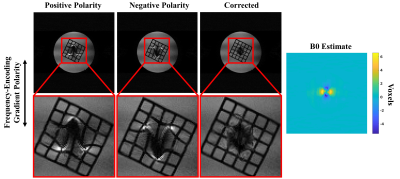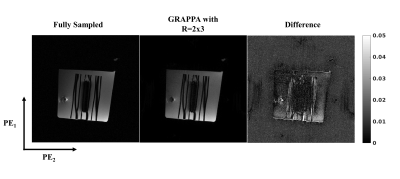Michael Mullen1 and Michael Garwood1
1Center for Magnetic Resonance Research and Department of Radiology, University of Minnesota, Minneapolis, MN, United States
1Center for Magnetic Resonance Research and Department of Radiology, University of Minnesota, Minneapolis, MN, United States
The
authors previously reported a broadband, low flip angle method at 1.5T to image
near metallic implants quickly relative to non-selective multispectral
approaches. Herein this approach is demonstrated to achieve 1mm3 resolution
at 3T with a large 3D FOV and scan time of ~8.74 minutes.

An experimental demonstration of the distortion
correction technique, showing a single plane along the second phase encoded
dimension of the image to highlight the correction along the frequency encoded
axis. Zoomed insets show the geometric and intensity distortion correction, and
the B0 estimate is in units of voxels. The receiver bandwidth was 650 Hz/voxel,
so the B0 estimate in this plane corresponds to approximately +/- 3250kHz.

A comparison of the normalized fully sampled reconstruction
to the accelerated reconstruction for one gradient polarity in a single plane
along the frequency encoding dimension. There are some small high spatial
frequency artifacts along the edges of the plastic grid in the phantom, but the
residual aliasing artifacts are extremely minor. The peak SNR in the fully
sampled cross section shown is approximately 97.43, and approximately 36.83 in
the accelerated scan, in good agreement with the g-factor map and the
acceleration (R=3x2) used.
